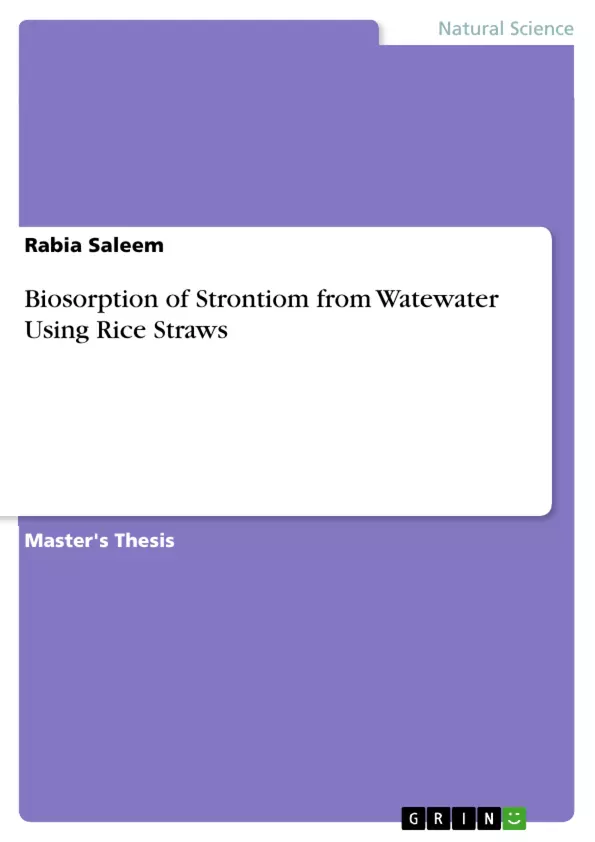In the present study, the biosorption behavior of rice straws biochar beads was investigated for strontium removal from wastewater bodies. Strontium occurs naturally at the average amount of 0.04% and is considered the 15th most abundant element of earth’s crust. It is recognized as one of the environmentally hazardous constituents and acts as a major pollutant in nuclear water discharges. It is widely used in electronics, pharmaceutical, pyrotechnics, and metallurgical industries that release strontium-rich watewater. Therefore, it is vital to remove it from the wastewater bodies. The biosorption process was carried out by using beads of rice straws biochar used as biosorbent.
Inhaltsverzeichnis (Table of Contents)
- Chapter no 1: INTRODUCTION.
- Heavy metals pollution in water sources: ....
- Strontium:
- Occurrence:.
- Importance of Strontium:...
- Conventional methods for heavy metals removal:.
- Biosorption:
- Chapter no 2: REVIEW OF LITERATURE..
- Heavy metals sources:
- Definition of Biosorption.........
- Biosorbents
- Significance of biosorbents for wastewater treatment..
- Strontium recovery by using different biosorbents
- Chapter no 3: MATERIAL AND METHOD.
- Methodology...
- Preparation of stock solution
- Collection of Biosorbent.
- Preparation of Rice straws biochar.
- Preparation of alginate beads.
- Biosorption experiment..
- Preparation of indicator.........
- EDTA solution for titration.......
- Determination of metal concentration by titrimetric method
- Optimization of biosorption parameters
- Fourier Transform Infrared Spectrometer (FTIR)
- SEM Analysis
- Chapter no. 4: RESULTS AND DISCUSSION..
- Effect of contact time
- Effect of dosage of RSBC
- Effect of Temperature...
- Effect of initial concentration ......
- Effect of agitation .......
- Chapter no. 5: SUMMARY
Zielsetzung und Themenschwerpunkte (Objectives and Key Themes)
This thesis investigates the potential of rice straws as a biosorbent for removing strontium from wastewater. The research aims to develop an environmentally friendly and cost-effective method for removing this heavy metal from contaminated water sources.
- The impact of heavy metals pollution on water sources.
- The importance and occurrence of strontium in the environment.
- The effectiveness of biosorption as a method for removing heavy metals.
- The use of rice straws as a sustainable and economical biosorbent for strontium removal.
- The optimization of biosorption parameters for achieving maximum strontium removal.
Zusammenfassung der Kapitel (Chapter Summaries)
- Chapter 1: INTRODUCTION. This chapter provides an overview of heavy metal pollution in water sources, focusing on strontium. It discusses the occurrence, importance, and environmental implications of strontium. The chapter also introduces conventional methods for heavy metal removal and the advantages of biosorption as an alternative approach.
- Chapter 2: REVIEW OF LITERATURE. This chapter delves into the existing research on heavy metals sources, the definition of biosorption, and the use of various biosorbents. It specifically examines the significance of biosorbents for wastewater treatment and highlights previous studies on strontium recovery using different biosorbents.
- Chapter 3: MATERIAL AND METHOD. This chapter outlines the methodology employed in the research. It details the preparation of the stock solution, the collection and preparation of rice straws, and the creation of rice straws biochar. The chapter also describes the biosorption experiment, the preparation of indicators and EDTA solutions, the method for determining metal concentration, and the optimization of biosorption parameters. The chapter concludes with an explanation of the analytical techniques used, including Fourier Transform Infrared Spectroscopy (FTIR) and Scanning Electron Microscopy (SEM).
- Chapter no. 4: RESULTS AND DISCUSSION. This chapter presents and discusses the results obtained from the biosorption experiments. It examines the effects of various parameters on strontium removal, such as contact time, biosorbent dosage, temperature, initial concentration, and agitation. The chapter analyzes the data and provides explanations for the observed trends.
Schlüsselwörter (Keywords)
The main keywords and focus topics of this thesis include biosorption, strontium, wastewater treatment, rice straws, heavy metals, environmental remediation, biochar, and sustainable technologies.
- Arbeit zitieren
- Rabia Saleem (Autor:in), 2019, Biosorption of Strontiom from Watewater Using Rice Straws, München, GRIN Verlag, https://www.grin.com/document/1284513



